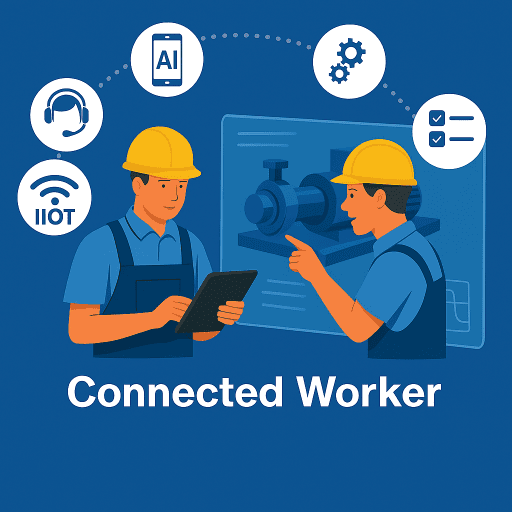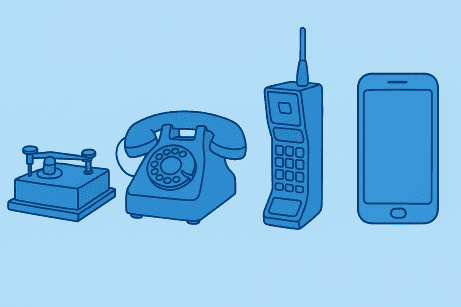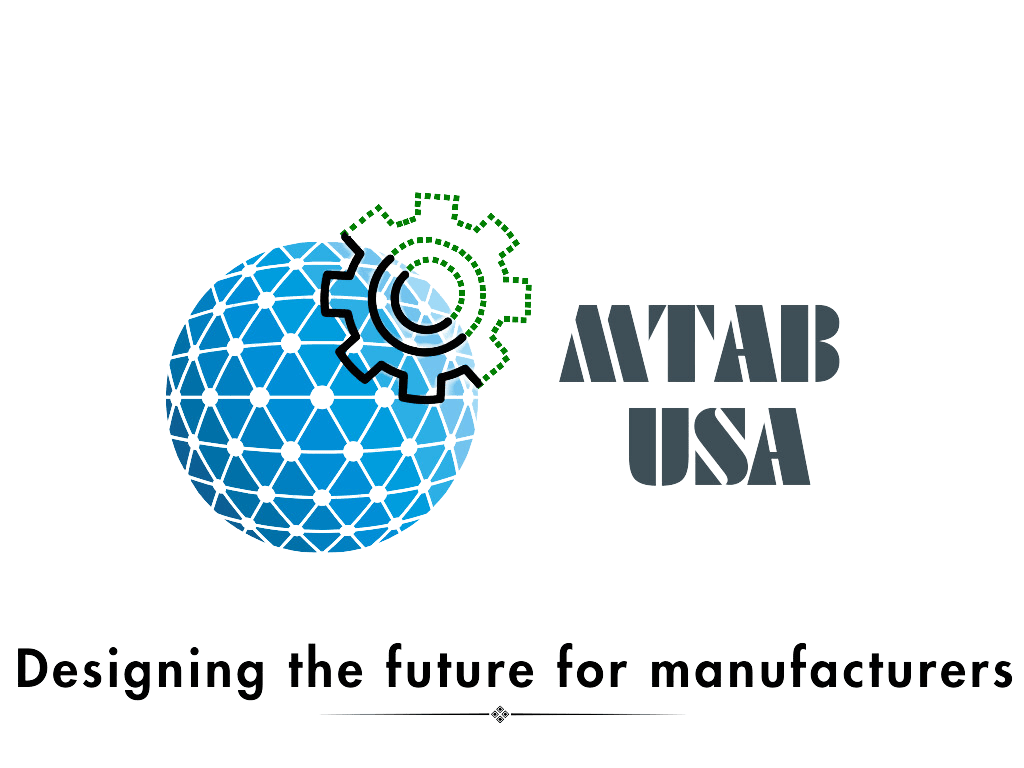Series: Designing Intelligence – The Strategic Use of Digital Twins in OEM Manufacturing
Introduction to the Series
In this three-part series, we explore how digital twins can help OEM manufacturers move from reactive decision-making to intelligent, data-driven operations. From early-stage design to procurement strategy and workforce enablement, digital twins—when implemented beyond surface-level 3D models—can serve as an integrated, cross-functional foundation for growth and resilience. The discussion is focused towards OEM in industrial engineered goods segments.
This three-part series explores how digital twins can serve as a force multiplier across:
Part 2: Operational Digital Twins for shopfloor and supply chain management
Part 3: Connected worker enablement and training scalability

Part 3 – Human-Centered Intelligence: How Digital Twins Empower the Connected Worker in OEM Manufacturing
Introduction: The Human Edge of Digital Transformation
OEM manufacturers are expected to respond to the growing technology adoption by their customers and the transformation in their industry. Between 2020 to now, the ask for visibility of usage and KPIs at the equipment level have rapidly risen among users of OEM equipment.
In a factory floor environment facing rising complexity, aging workforces, and high turnover, the Connected Worker strategy is not a "nice to have." It is a competitive necessity. And digital twins play a critical role in making that strategy real. This strategy also affords new avenues for monetization since many of the OEM customer are facing the same challenges.
In this third and final part of the series, we explore how digital twins help OEMs strengthen their workforce through knowledge transfer, immersive training, real-time guidance, and engagement that drives retention.

📺 A Quick Story on Generational Shifts
Before we dive in, let me share a quick story that highlights how dramatically perspectives have changed.
About ten years ago, a toddler visited our home. He spotted our flat-screen TV, walked right up to it, and started tapping the screen—expecting it to change apps, just like a tablet. To him, it wasn’t a television—it was a giant touchscreen.
That moment stuck with me. It is a perfect example of how the next generation thinks differently about interaction, learning, and technology. They expect digital to be intuitive, responsive, and integrated—and they bring those expectations to the workplace too.1. Capturing and Transferring Tribal Knowledge
In OEM manufacturing, different roles—from assembly technicians and field service engineers to calibration teams and quality inspectors—rely on decades of hard-earned knowledge. Much of what makes production successful is invisible: tribal knowledge passed from veteran operators through informal conversations, trial-and-error, and years of repetition. At our factory, one of our 25+ years' tenured production supervisor could take one look at mechanical issue, know exactly what caused it and how to resolve it. The problem? This knowledge does not scale, and it often walks out the door.
Digital Twins can be used as assets to showcase how shopfloor workforce and production executives build repeatably through Process, Practice, Consistency and Problem-Solving. When thoughtfully designed, digital twins help close that gap by turning unspoken knowledge into a structured, accessible format that supports every role on the floor. These tools allow teams to:
Embed operational insights directly into process simulations. Today's AI-based vision systems can watch 60–100 assembly builds and automatically identify the sequence of work instructions, tools needed, and the problem areas to watch out. (Most recently, I saw an interesting demo of Retrocausal ).
The older-hands can annotate procedures with warnings, tips, or alternative approaches (Quarter20 has been doing some fantastic work by integrating with CAD).
Create shared, visual references accessible to all shifts and facilities
Enable workers to contribute feedback or updates to the twin—flagging steps that cause confusion or proposing improvements. This keeps the digital twin relevant and collaborative.
This isn’t just about documentation. It is about transforming unstructured human know-how into a repeatable, shareable, and upgradable operational asset.
2. Scenario-Based Training and Virtual Walkthroughs
For most next-gen talent and the career influencers in their lives, manufacturing still evokes the picture of labor-intensive, grease-filled work. To talent entering the workforce, the manufacturing floor can be daunting, rigid, and overly structured. Using digital twins and immersive tools, we can address these concerns and educate them on the meaning behind these procedures and standards—how they ensure safety, quality, and reliability in the physical products we all rely on.
Pairing digital twins with AR/VR, tablet-based interfaces or dashboards enables immersive, scenario-based training. Workers can interact with real-world simulations of compliance & safety, complex assemblies, changeovers, and service routines before ever touching the line. (Check out DeepSight andtheir work in compliance and scenario-based training.)
The real value? These environments allow workers to make mistakes without disastrous consequence, reflect on what went wrong, and reinforce correct procedures in a safe way. This builds confidence and instills a deeper understanding of why each step matters—critical for safe operation and consistent quality. OEM equipment is often highly integrated, combining mechanical, electrical, and programmable elements. Training through digital twins helps workers develop practical fluency with these systems.
Because these simulations reflect actual equipment, layouts, and product variants, training becomes contextual, not theoretical. Workers are not just memorizing steps—they are developing judgment and muscle memory to perform effectively on the floor.
3. Real-Time Decision Support on the Floor
A digital twin isn’t just for engineers—it is a decision support platform tailored to each role on the floor.
Assembly technicians can check build instructions that update with the product variant.
Quality inspectors can visualize tolerance limits and recent deviations.
Field service teams can simulate a fault scenario before going on-site.
Maintenance techs can anticipate required interventions based on digital logs.
OEM environments often run on a mix of legacy equipment, PLC-based systems, and modern controls. Digital twins serve as a layer that brings these elements together, helping workers make sense of system-level interactions and operate more effectively.
When connected workers can access a real-time view of operations through one of the many gadgets, they gain:
Live machine status and material availability
Context-sensitive work instructions and tools
Alerts tied to current part mix, shift, or customer requirements
This kind of support helps frontline teams move from simply executing tasks to actively solving problems. It reduces escalations, increases throughput, and empowers workers to operate with confidence.
It also allows for faster alignment with engineering when last-minute changes occur. Instead of waiting for clarification, workers can see the updates directly in the twin—with full traceability and impact context.
4. Building Engagement and Retaining Talent
Digital enablement is not just about output—it is about people.
Frontline workers today, especially Gen Z and younger millennials, expect digital continuity between their social lives and work environments. They want tools that are intuitive, mobile, and responsive. They expect transparency, feedback loops, and autonomy.
They also want to spend less time on administrative tasks. Automated data capture, workflow automation, and GenAI-powered assistants can significantly reduce paperwork and help them focus on problem-solving and collaboration.
Digital twins can deliver on those expectations by:
Offering real-time guidance and troubleshooting tools
Enabling remote access to experts for faster problem-solving
Automating repetitive tasks, data capture, and form completion
Creating role-specific dashboards and mobile interfaces that adapt to each user’s needs
However, digital tools alone do not guarantee adoption. For many OEMs, the shift to connected systems requires thoughtful change management. Veteran workers may be skeptical, while new employees might need coaching. Success depends on cross-generational mentoring, training, and workforce members who model adoption.
Many OEMs also operate with fragmented systems—legacy ERP, standalone training platforms, and homegrown MES solutions. The good news? Digital twins can layer onto these systems using APIs and data connectors. This approach allows organizations to build connectivity step by step, without needing to overhaul everything at once. (Note: Sometimes, you do need to rip out that existing system and put in a new one, due to too much baggage.)
This kind of empowerment directly impacts retention. According to McKinsey, it costs $52,000 to replace a single frontline manufacturing worker who leaves. Reducing churn by even a small margin translates to major gains in cost and continuity. Better training through digital twins can also shorten onboarding by up to 30–40%, and reduce early-stage production errors—directly impacting efficiency and quality.
OEMs can measure success using metrics like:
Time to proficiency for new hires
Reduction in rework or quality escapes
Number of escalations resolved at the operator level
Utilization of training modules or knowledge contributions
Source: From hire to inspire: Getting and keeping Gen Z in manufacturing
5. New Revenue Opportunities from the Connected Worker Strategy
What OEMs implement for their internal processes and people can become valuable differentiators in the products and services they offer customers. When digital twins are used to eliminate non-value-adding tasks, automate repetitive processes, and improve real-time decision-making, these capabilities can be embedded as features into the equipment or bundled as value-added services.
The challenges OEMs face internally—such as improving visibility, increasing flexibility, and addressing workforce skill gaps—are often mirrored by their customers. The systems and tools OEMs build to support their own connected workforce can be productized and extended to clients who are also seeking to modernize their factory operations.
For example:
A digital twin originally used for operator guidance and maintenance tracking can become a customer-facing application.
Knowledge capture platforms for tribal wisdom can be integrated into after-sales support systems.
Real-time dashboards used by OEM line leads can be repackaged as part of remote monitoring solutions for clients.
This creates a dual benefit:
- OEMs improve internal performance and workforce capability.
- These investments open new commercial pathways through service contracts, digital subscriptions, or premium equipment options.
Workers, who feel supported and valued are more likely to stay, grow, and lead—strengthening the factory’s long-term capability. This win-win scenario creates a flywheel effect of developing human capital and smart tools across the manufacturing value chain.
Conclusion: People, Not Just Processes
Digital twins started as tools to model machines, but their greatest impact may be in modeling and supporting people. In the context of the Connected Worker strategy, digital twins become co-pilots for the modern factory operator: preserving knowledge, guiding action, and fostering a culture of learning.
If the first wave of Industry 4.0 was about systems, the next wave is about humans. And the digital twin brings them together.
Building a Connected Worker strategy is a necessity driven by the changing demographic profile of the workforce, adoption of manufacturing technology solutions and the flexibility required to meet customer requirements and preferences.
Thank you for following the series. If you missed Part 1 (Design-Side Intelligence) or Part 2 (Operational Digital Twin), they are linked here.